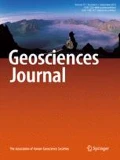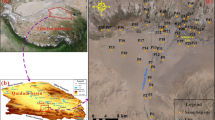Abstract
Groundwater is important for domestic, industrial, and agricultural uses in Ho Chi Minh City, Vietnam. As the city has developed in a coastal environment, the issue of the fresh water supply must be solved for continuous development. The aim of this study was to quantitatively estimate the risk of groundwater salinization in the Ho Chi Minh area due to saline water intrusion into the main coastal aquifer (the Upper Pliocene aquifer) based on field monitoring data, and to evaluate the sustainability of the city with respect to groundwater resources. From the national monitoring database, water level data were obtained for the last 10 years (2000 to 2009), and a total of 33 hydrogeochemical and isotope data sets were obtained from the aquifer. The sustainability of Ho Chi Minh City with respect to the groundwater supply was quantitatively evaluated at an aquifer scale using groundwater sustainability indicators (GWSIs) suggested by the UNESCO/IAEA/IAH Working Group. The results indicated that groundwater in the southern region, part of the western region, and the area along the Saigon riverside was of poor quality, with very high total dissolved solids (>1,000 mg/L) and high concentrations of Cl and Fe, exceeding the World Health Organization’s drinking water guidelines. The Br:Cl ratios and the δ2H and δ18O values of the samples indicated that the salinization of groundwater resulted mainly from mixing with seawater over a long period. During 2004–2009, the saline boundary moved inland, with the farthest distance reaching ∼3.2 km. The long-term abstraction of groundwater, which has been much greater than its recharge capability, is probably causing the decline in water level (in 39% of the aquifer area), the degradation of groundwater quality (in 62% of the area), and the continuously expanding saline water intrusion (by 7.4% in 5 years). Thus, for the sustainable development of Ho Chi Minh City, in addition to passive measures to regulate over-pumping and pollution controls, active measures should be considered to prevent further seawater intrusion and to increase groundwater recharge through artificial recharge or better management of aquifer recharge (MAR).
Similar content being viewed by others
References
Alexakis, D., 2011, Assessment of water quality in the Messolonghi-Etoliko and Neochorio region (West Greece) using hydrochemical and statistical analysis methods. Environmental Monitoring and Assessment, 182, 397–413.
Allow, K.A., 2011, The use of injection wells and a subsurface barrier in the prevention of seawater intrusion: a modelling approach. Arabian Journal of Geosciences, DOI 10.1007/s12517-011-0304-9.
Andreasen, D.C. and Fleck, W.B., 1997, Use of bromide:chloride ratios to differentiate potential sources of chloride in a shallow, unconfined aquifer affected by brackish-water intrusion. Hydrogeology Journal, 5, 17–26.
Bouwer, H., 2002, Artificial recharge of groundwater: hydrogeology and engineering. Hydrogeology Journal, 10, 121–142.
Bui, T.V., 2010, Report of editing geological, hydrogeological and engineering geological map, scale 1:50,000 in Ho Chi Minh city. Division for Water Resources Planning and Investigation for the South of Viet Nam, 450 p. (in Vietnamese)
Craig, H., 1961, Isotopic variations in meteoric waters. Science, 133, 1702–1703.
Dan, N.P., Ha, N.T.V., Thanh, B.X., Nga, N.V., and Khoa, L.V, 2007, Sustainable groundwater management in Asian Cities: a final report of research on sustainable water management policy, water resources management in Ho Chi Minh City. International Global Environmental Strategy, Hayama, p. 68–79.
Dan, N.P., Thanh, B.X., and Truong, B.D., 2006, Case studies of groundwater pollution in southeast Vietnam. International Review for Environmental Strategies, 6, 361–371.
Department of natural resources and environment Ho Chi Minh city, 2009, Statistical report of statement of groundwater exploitation in Ho Chi Minh city. Department of natural resources and environment, Ho Chi Minh city, 125 p. (in Vietnamese)
Dillon, P., 2005, Future management of aquifer recharge. Hydrogeology Journal, 13, 313–316.
Freeze, R.A. and Jerry, J.A., 1979, Groundwater. Prentice-Hall, Englewood Cliffs, 604 p.
Girman, J., 2007, Implementation of groundwater indicators in the Republic of South Africa. In: Lipponen, A. (ed.), Groundwater resources sustainability indicators. The International Hydrological Programme (IHP) Groundwater Series, 14, UNESCO, Paris, p. 85–98.
Hamed, K.H. and Rao, A.R, 1998, A modified Mann-Kendall trend test for autocorrelated data. Journal of Hydrology, 204, 182–196.
Hirata, R., Suhogusof, A.V., and Fernandes, A., 2007, Groundwater resources in State of Sao Paulo, Brazil. In: Lipponen, A. (ed.), Groundwater resources sustainability indicators. The International Hydrological Programme (IHP) Groundwater series, 14, UNESCO, Paris, p. 73–84.
Ho Chi Minh city, 2010a, Statistical yearbook. Statistical office, Ho Chi Minh city, 255 p. (in Vietnamese)
Ho Chi Minh city, 2010b, Statistical report of groundwater abstraction in Ho Chi Minh city. Department of Natural Resources and Environment, 151 p. (in Vietnamese)
Hong, S.H., Shi, L., Cui, L., and Park, N.S., 2009, Artificial Injection to Control Saltwater Intrusion in Groundwater-Numerical Study on a Vertical Cross Section. Engineering Geology Journal, 19, 131–138.
Ibrakhimov, M., Martiusb, C., Lamersa, J.P.A., and Tischbeina, B., 2011, The dynamics of groundwater table and salinity over 17 years in Khorezm. Agricultural Water Management, 101, 52–61.
Jorreto, S., Pulido-Bosch, A., Gisbert, J., Sánchez-Martos, F., and Francés, I., 2009, The fresh water-seawater contact in coastal aquifers supporting intensive pumped seawater extractions: A case study. Comptes Rendus Geoscience, 341, 993–1002.
Karahanoglu, N., 1997, Assessment of seawater intrusion in a coastal aquifer by using correlation, principal component, and factor analyses. Water Environment Research, 69, 331–341.
Kendall, M.G., 1975, Rank correlation methods. Griffin, London, 272 p.
Knuth, M., Jackson, J.L., and Whittemore, D.O.,1990, An intergrated approach to identifying the salinity source contaminating a groundwater supply. Groundwater, 28, 207–214.
Kim, Y.J., Lee, K.S., Koh, D.C., Lee, D.H., Lee, S.G., Park, W.B., Koh, G.W., and Woo, N.C., 2003, Hydrogeochemical and isotopic evidence of groundwater salinization in a coastal aquifer: a case study in Jeju volcanic island, Korea. Journal of Hydrology, 270, 282–294.
Lamba´n, L.J, Martos, S., and Rodríguez-Rodríguez, M., 2011, Application of groundwater sustainability indicators to the carbonate aquifer of the Sierra de Becerrero (Southern Spain). Environment Earth Sciences, 64, 1835–1848.
Lavapuro, M., Lipponen, A., Artimo, A., and Katko, T.S., 2008, Groundwater sustainability indicators: testing with Finnish data. Boreal Environment Research, 13, 381–402.
Mann, H.B., 1945, Nonparametric tests against trend. Econometria, 13, 245–259.
Mantoglou, A., 2003, Pumping management of coastal aquifers using analytical models of saltwater intrusion. Water Resources Research, 39, DOI:10.1029/2002WR001891.
Mendizabal, I. and Stuyfzand, P.J., 2009, Guidelines for interpreting hydrochemical patterns in data from public supply well fields and their value for natural background groundwater quality determination. Journal of Hydrology, 379, 151–163.
Morgan, L.K., Werner, A.D., and Simmons, C.T., 2012, On the interpretation of coastal aquifer water level trends and water balances: A precautionary note. Journal of Hydrology, 470–471, 280–288.
Morris, A.W. and Riley, J.P., 1996, The bromide/chlorinity and sulphate/ chlorinity ratio in seawater. Deep-sea research, 13, 699–705.
Nguyen, H.D. and Tran, V.K., 2003, Result of determining N-Q formation and studying geological structure of Southern delta, Viet Nam. Viet Nam Geology and Mineral Agency, Ha Noi, 350 p. (in Vietnamese)
Nguyen, Q.D., 1991, Report of groundwater investigation in Cu Chi and Hoc Mon areas, Ho Chi Minh city. Viet Nam Geology and Mineral Agency, Ha Noi, 210 p. (in Vietnamese)
Nguyen, T.V., 2008, Report of groundwater monitoring result in Ho Chi Minh city. Department of natural resources and environment Ho Chi Minh city, 50 p. (in Vietnamese)
Nguyen, V.N., 1998, Report of evaluating statement of groundwater exploitation in Ho Chi Minh city. Department of natural resources and environment Ho Chi Minh city, 200 p. (in Vietnamese)
Park, Y., Lee, J.Y., Kim, J.H., and Song, S.H., 2012, National scale evaluation of groundwater chemistry in Korea coastal aquifers: evidences of seawater intrusion. Environmental Earth Sciences, 66, 707–718.
Pernía, J. and Lamba´n, L., 2007, Groundwater indicators in Sierra de Estepa (Seville, Spain). In: Lipponen, A. (ed.), Groundwater resources sustainability indicators. The International Hydrological Programme (IHP) Groundwater series, 14, UNESCO, Paris, p. 44–51.
Quyet dinh 69/2007/QÐ-UBND, 2007, Regulations about Restriction and prohibition of groundwater exploitation in Ho Chi Minh city. Ho Chi Minh city’s People Committee, 10 p. (in Vietnamese)
Richter, B.C. and Kreitler, C.W., 1991, Indentification of sources of groundwater salinization using geochemical techniques. U.S Environmental protection agency, 259 p.
Richter, B.C. and Kreitler, C.W., 1993, Geochemical techniques for identifying sources of ground-water salinization. C.K. Smoley, Boca Raton, 258 p.
Shadmani, M., Marofi, S., and Roknian, M., 2012, Trend analysis in reference evapotranspiration using Mann-Kendall and Speearman’s Rho tests in Arid regions of Iran. Water resources mangement, 26, 211–224.
Shi, J.S., Wang, Z., Zhang, Z.J., Fei Y.H., Li, Y.S., Zhang, F.E., Chen, J.S., and Qian, Y., 2011, Assessment of deep groundwater overexploitation in the North China Plain. Geoscience Frontiers, 2, 593–598.
Sophiya, M.S. and Syed, T.H., 2013, Assessment of vulnerability to seawater intrusion and potential remediation measures for coastal aquifers: a case study from eastern India. Environment Earth Sciences, DOI 10.1007/s12665-012-2206-x.
TCXDVN33, 2006, Design standard for water supply-distribution system and facilities. Vietnam Industrial Agency, Hanoi, 158 p. (in Vietnamese)
Tran, H.P., 1998, Report of hydrogeological investigation in the South of Viet Nam. Viet Nam Geology and Mineral Agency, Ha Noi, 320 p. (in Vietnamese)
Trinh, H.T., 2002, Distribution of iron concentration in groundwater in Ho Chi Minh city. M.S. thesis, Ho Chi Minh city University of Technology, Ho Chi Mihn, 150 p. (in Vietnamese)
UNDP Human Development Report, 2006, Water: A human right. United Nations Development Programme, NewYork, 422 p.
Vinson, D.S., Schwartz, H.G., Dwyer, G.S., and Vengosh, A., 2011, Evaluating salinity sources of groundwater and implications for sustainable reverse osmosis desalination in coastal North Carolina, USA. Hydrogeology Journal, 19, 981–994.
Vrba, J. and Lipponen, A, 2007, Groundwater resources sustainability indicators. Groundwater series, 14, UNESCO, Paris, 114 p.
Xun, Z., Xia, Y., Juan, L., Jinmei, Y., and Wenyu, D., 2007, Evolution of the groundwater environment under a long-term exploitation in the coastal area near Zhanjiang, China. Environmental Geology, 51, 847–856.
Werner, A.D. and Simmons, C.T., 2009, Impact of sea-level rise on seawater intrusion in coastal aquifers. Groundwater, 47, 197–204.
WHO, 2011, Guidelines for drinking-water quality (4th edition). WHO, Geneva, p. 541.
Wu, H., Soh, L.K., Samal, A., and Chen, X.H., 2008, Trend analysis of stream flow drought events in Nebraska. Water resource management, 22, 145–164.
http://www.unep.org/urban_environment/issues/coastal_zones.asp.
Author information
Authors and Affiliations
Corresponding author
Rights and permissions
About this article
Cite this article
Ngo, M.T., Lee, J.M., Lee, H.A. et al. The sustainability risk of Ho Chi Minh City, Vietnam, due to saltwater intrusion. Geosci J 19, 547–560 (2015). https://doi.org/10.1007/s12303-014-0052-4
Received:
Accepted:
Published:
Issue Date:
DOI: https://doi.org/10.1007/s12303-014-0052-4




